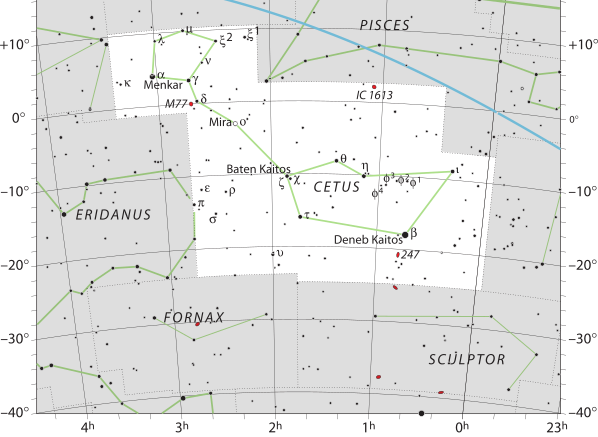The constellation Cetus has a been depicted in many ways through history as several cultures have each had different depictions and mythologies for the constellation. The constellation represents in sea monster in Greek mythology, and is sometimes referred to as ‘the whale.’
Cetus is in the region of the sky that contains other water-related constellations: Aquarius, Pisces and Eridanus.
Cetus is not a member of neither the 12 true zodiac constellations, nor classical 12-part zodiac. The ecliptic passes less than 0.25° from one of its corners. Thus the moon and planets will enter Cetus in 50% of their successive orbits briefly and the southern part of the sun appears in Cetus for about one day each year.
| Applicable Information | |
| Visibility In Pacific Northwest | July to March |
| Best Times To View | November |
| Right Ascension | 00h 26m 22.2486s–03h 23m 47.1487s |
| Declination | 10.5143948°–−24.8725095° |
| Area | 1231 square degrees |
| Main Stars | 14 |
| Brightest Object | β Cet |
| Meteor showers | October Cetids, Eta Cetids, Omicron Cetids |
| Messier objects | 1 |
| Neighboring Constellations | Aries, Pisces, Aquarius, Sculptor, Fornax, Eridanus, Taurus |
History
Cetus may have originally been associated with a whale, which would have had mythic status amongst Mesopotamian cultures.
In Chinese astronomy, the stars of Cetus are found among two areas: the Black Tortoise of the North and the White Tiger of the West.
The Tukano and Kobeua people of the Amazon used the stars of Cetus to create a jaguar, representing the god of hurricanes and other violent storms. In Hawaii, the constellation was called Na Kuhi, and Mira (Omicron Ceti) may have been called Kane.
The constellation is often called the Whale, though it is most strongly associated with Cetus the sea-monster, who was slain by Perseus as he saved the princess Andromeda from Poseidon’s wrath. Cetus is located in a region of the sky called “The Sea” as its place in thee night sky has many water-associated constellations in the area, which include Eridanus, Pisces, Piscis Austrinus, Capricornus, and Aquarius.
In the 17th century, Cetus was depicted as a “dragon fish” by Johann Bayer. Both Willem Blaeu and Andreas Cellarius depicted Cetus as a whale-like creature in the same century. However, Cetus has also been variously depicted with animal heads attached to a piscine body.
Stars
Cetus has several well known stars in the constellation including Diphda (Beta Ceti), Menkar (Alpha Ceti), Tau Ceti and the famous variable star Mira(Omicron Ceti).
Deep-sky objects
Cetus lies far from the galactic plane and are not obscured by thee dust from the Milky Way. This means that there are many distant galaxies are visible to astronomers. The brightest distant galaxy is Messier 77, otherwise known as NGC 1068, which is a 9th magnitude spiral galaxy located near Delta Ceti. It appears face-on and has a clearly visible nucleus of magnitude 10. Located roughly 50 million light-years from Earth, M77 is also a Seyfert galaxy and thus a bright object in the radio spectrum.
Other interest objects found in Cetus is the massive cD galaxy Holmberg 15A, spiral galaxy NGC 1042, and the ultra-diffuse galaxy NGC 1052-DF2.
IC 1613 is an irregular dwarf galaxy near the star 26 Ceti and is a member of the Local Group that includes the Milky Way.
NGC 246 is a planetary nebula with a magnitude of 8.0, which has gotten the nickname among some amateur astronomers “Pac-Man Nebula” because of the arrangement of its central stars and the surrounding star field.
Make sure to check out other articles on the site, including a brief introduction to constellations, other constellation articles, and more!

Be the first to comment on "Cetus"